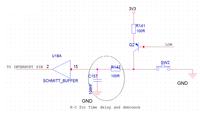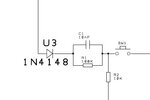tiwari.sachin
Full Member level 6
I am using a switch (when pressed I get a zero), otherwise its high. Quite simple and straight forward
I am connecting the output to the MCU interrupt line
The debounce on the switch can confuse the flipflops that are used on interrupt block and hence I want to have a clean signal there
R-C followed by a schmitt is what I am thinking about.
But then, do I have a better option?

In the above SCH, 3V3 is turned on by a transistor (Need this for some other purpose too, hence using)
When switch is pressed, RC will add the time delay to provide the variation from 1 to 0. Depending on time required, I need to change values of R142 and C157)
Followed by a schmitt which will give a 0 or a 1 and not other value.
Is this right?
I have tried without RC and sch and sometime interrupt works and sometimes doesnt and I think debounce is causing MCU to behave abruptly.
I am connecting the output to the MCU interrupt line
The debounce on the switch can confuse the flipflops that are used on interrupt block and hence I want to have a clean signal there
R-C followed by a schmitt is what I am thinking about.
But then, do I have a better option?

In the above SCH, 3V3 is turned on by a transistor (Need this for some other purpose too, hence using)
When switch is pressed, RC will add the time delay to provide the variation from 1 to 0. Depending on time required, I need to change values of R142 and C157)
Followed by a schmitt which will give a 0 or a 1 and not other value.
Is this right?
I have tried without RC and sch and sometime interrupt works and sometimes doesnt and I think debounce is causing MCU to behave abruptly.
